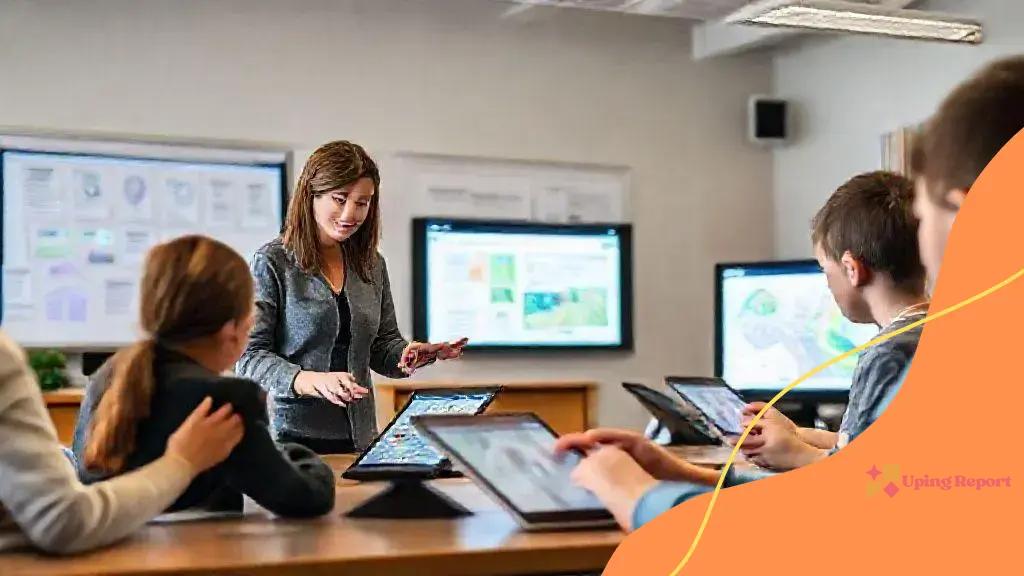eclassroomtools: Transform your learning experience today

eclassroomtools enhance the educational experience by providing personalized learning, immediate feedback, and collaboration opportunities, making education more accessible and effective for all students.
Curious about how eclassroomtools can change your educational approach? This exciting technology blends traditional teaching with modern solutions, ensuring students engage effectively. Let’s explore its impact and benefits.
Understanding eclassroomtools
Understanding eclassroomtools is essential for anyone looking to enhance their educational experience. These tools offer innovative ways to make learning more engaging and effective, transforming the traditional classroom into an interactive space.
What Are eclassroomtools?
eclassroomtools are digital resources designed to facilitate learning. These tools range from learning management systems to interactive software that promotes collaboration among students and teachers. They provide a platform for teachers to create, manage, and share educational content seamlessly.
Key Features of eclassroomtools
Some features that stand out include:
- User-friendly interfaces that encourage participation.
- Real-time collaboration tools for group projects.
- Customization options for different learning styles.
- Analytics to track student performance and engagement.
With these features, educators can tailor their teaching methods to meet diverse student needs. The adaptability of eclassroomtools means they can be used in various subjects and areas of study.
Moreover, these tools promote critical thinking and creativity, essential skills for today’s learners. By using technology effectively, teachers can create a dynamic learning environment that keeps students motivated and involved in their education. Using eclassroomtools fosters collaboration, allowing students to learn from each other, which can enhance their understanding of complex topics.
With the right tools, the classroom can become a vibrant hub of knowledge and exploration. Teachers can implement exciting projects that require student input and creativity, making lessons more impactful.
As we delve deeper into how to integrate these tools into a curriculum, it’s clear that the future of education lies in embracing digital advancements.
Key features of eclassroomtools
When exploring the key features of eclassroomtools, it’s essential to understand how these elements enhance the learning experience. These features are designed to foster engagement, collaboration, and personalized education for students.
Interactive Learning
One of the standout aspects of eclassroomtools is their ability to create interactive learning environments. Students can engage with the material actively, whether through quizzes, simulations, or collaborative projects.
Customizable Content
Educators can customize their teaching materials to fit their specific needs. This flexibility allows for:
- The incorporation of multimedia resources.
- The alignment of content with state or national standards.
- The adaptation for varied learning styles, ensuring all students can thrive.
With customizable content, teaching becomes more relevant and exciting.
Real-Time Feedback
Another vital feature is the ability to provide real-time feedback to students. This immediate response helps students understand their strengths and areas they need to improve. Teachers can quickly assess comprehension, helping to guide instruction more effectively.
Moreover, these tools often include analytics dashboards. These dashboards allow educators to track student performance over time, identifying trends and patterns that can inform future lesson planning.
eclassroomtools also enhances communication between teachers, students, and parents. Messaging features and discussion forums foster a collaborative atmosphere. This strong line of communication ensures everyone is on the same page regarding student progress.
Ultimately, the features of eclassroomtools lead to a more enriched educational environment. The interactivity, customization, feedback, and communication tools all serve to create a learning experience that is both effective and enjoyable.
How to integrate eclassroomtools in your curriculum

Integrating eclassroomtools into your curriculum can enhance the educational experience significantly. By incorporating these tools, you can offer students an engaging and interactive learning environment.
Assess Your Needs
The first step in integration is to assess your specific teaching needs. Identify areas where technology can improve engagement or understanding. Consider your students’ learning styles and preferences to tailor the use of these tools effectively.
Select Appropriate Tools
Choosing the right eclassroomtools is crucial. Look for tools that offer:
- Features that align with your curriculum goals.
- Ease of use for both teachers and students.
- Compatibility with existing technology.
- Strong support resources and communities.
These factors ensure a smoother transition and more successful implementation.
Plan Your Lessons
Once you’ve selected the tools, it’s time to plan your lessons. Start by incorporating eclassroomtools into a few key lessons to test their effectiveness. Use these tools to enhance existing materials, such as incorporating multimedia presentations or interactive quizzes that engage students.
Additionally, consider using these tools for collaborative projects, allowing students to work together online. This fosters teamwork and communication skills, which are essential in today’s world.
Provide Training
Training is essential for successful integration. Ensure that both teachers and students are comfortable with the eclassroomtools. Conduct workshops or training sessions to guide everyone through the features and uses. This preparation can help to alleviate any resistance or apprehension.
Furthermore, create a support system where students can seek help or clarification on using the tools. This guidance will empower them to take full advantage of the technology.
As you continue to integrate these tools, gather feedback from students and adjust your approaches accordingly. Encouraging open communication about what works and what doesn’t will help refine your methods over time.
Benefits of using eclassroomtools for students
Using eclassroomtools offers numerous benefits for students, enhancing their learning experience and engagement. These tools make education more interactive and tailored to individual needs, which can lead to better outcomes.
Enhanced Engagement
One of the most significant advantages is the enhanced engagement in the learning process. eclassroomtools incorporate interactive elements such as games, quizzes, and multimedia presentations. These features keep students interested and motivated to learn.
Personalized Learning
These tools enable personalized learning experiences. Students can learn at their own pace, allowing them to review materials or advance when they are ready. This flexibility caters to various learning styles and ensures that all students can achieve their best.
Collaboration Skills
Another key benefit is the development of collaboration skills among students. With tools that allow for group projects and discussions, students learn to work together effectively. They share ideas and help each other understand complex concepts.
Moreover, important skills such as communication and teamwork are fostered, which are essential for success both in school and in future workplaces. Also, using technology for collaboration prepares students for the demands of the modern world.
Immediate Feedback
eclassroomtools also provide immediate feedback, which is vital for learning. Students can assess their understanding of the material in real-time through quizzes and exercises. Quick feedback helps them identify areas that need improvement.
This instant communication allows educators to adjust their teaching strategies based on student performance, ensuring that all students receive the support they need.
Additionally, using these tools can foster a love for learning. When students feel engaged and supported, they are more likely to pursue knowledge beyond the classroom. This contributes to lifelong learning and motivation.
Future of education with eclassroomtools
The future of education with eclassroomtools is promising and exciting. As technology continues to evolve, these tools are becoming integral to how students learn and interact in the classroom.
Increased Accessibility
One major change is the increased accessibility to education. With eclassroomtools, students can access learning materials from anywhere at any time. This flexibility allows for a more inclusive education system that caters to diverse learning needs.
Blended Learning Environments
The integration of technology will likely lead to more blended learning environments. This approach combines traditional classroom settings with online resources, offering students the best of both worlds. They can benefit from face-to-face interactions while also utilizing digital tools to enhance their learning experience.
Focus on Critical Skills
Another important aspect of the future of education is the focus on developing critical skills. Educators will increasingly emphasize skills like problem-solving, collaboration, and critical thinking. eclassroomtools facilitate this by providing projects and activities that require students to apply these skills in real-world scenarios.
Data-Driven Insights
As technology advances, data-driven insights will become more prevalent. Educators will have access to detailed analytics about student performance. These insights can help tailor instruction to meet individual needs, ensuring that every student receives personalized support.
Additionally, the use of artificial intelligence may enable eclassroomtools to adapt content in real-time based on students’ grasp of concepts. This ability can create a more responsive learning environment, helping students to thrive.
Global Collaboration
The future will also see increased opportunities for global collaboration among students. eclassroomtools enable students to connect with peers from different parts of the world. They can work together on projects, share ideas, and gain diverse perspectives, enriching their learning experience.
In summary, the future of education with eclassroomtools holds great potential. As these tools become more integrated into educational practices, they will shape a more inclusive, accessible, and engaging learning environment for all students.
FAQ – Frequently Asked Questions about eclassroomtools
What are eclassroomtools?
eclassroomtools are digital resources designed to enhance the learning experience through interactive and engaging content, allowing students to learn effectively.
How do eclassroomtools benefit students?
They provide personalized learning, immediate feedback, and opportunities for collaboration, making education more accessible and engaging.
Can eclassroomtools be used in all subjects?
Yes, eclassroomtools are versatile and can be integrated into various subjects to enhance teaching and learning methods.
How can teachers start using eclassroomtools?
Teachers can begin by assessing their needs, selecting appropriate tools, planning lessons that incorporate these tools, and providing training for both students and staff.
